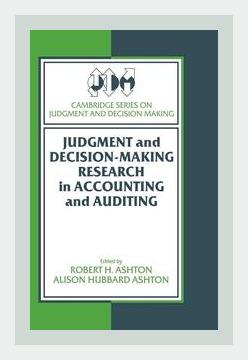Leadership and ManagementDecision Making
**
Introduction
“Judgment and Decision-Making Research in Accounting and Auditing” investigates the cognitive processes that accountants and auditors use when making decisions. The authors, Robert H. Ashton and Alison Hubbard Ashton, blend theoretical perspectives with empirical research to explore how judgments are formed and decisions are made in the contexts of accounting and auditing. By understanding these processes, the book aims to enhance the precision and reliability of decisions within these fields.
Chapter 1: Overview of Judgment and Decision-Making Research
Major Points:
- Historical Context: The origins and evolution of judgment and decision-making (JDM) research in accounting.
- Importance of JDM: How critical judgments and decisions affect organizational outcomes and financial accuracy.
Actions:
- Historical Awareness: Stay informed about the historical developments in JDM research to appreciate current practices’ foundations.
- Acknowledge Importance: Recognize the impact of sound judgment and decision-making on financial reporting quality and accuracy.
Chapter 2: Cognitive Processes Underlying JDM
Major Points:
- Heuristics and Biases: Explains common heuristics (e.g., availability, representativeness) and biases (e.g., overconfidence, anchoring) impacting accountants and auditors.
- Dual-Process Theory: Discussion on System 1 (automatic, intuitive) and System 2 (controlled, analytical) thinking.
Actions:
- Mitigate Biases: Use debiasing techniques like cross-checking information and seeking diverse perspectives to mitigate biases.
- Leverage Dual-Process Theory: Apply System 2 thinking for complex judgments requiring thorough analysis.
Example:
An accountant might fall prey to the availability heuristic, overestimating the probability of rare fraud cases due to recent high-profile incidents. To counteract this, they should review actual statistical data to inform their judgment.
Chapter 3: Expertise and Its Development
Major Points:
- Characteristics of Expertise: The role expertise plays in reducing cognitive load and improving decision accuracy.
- Training and Development: Strategies to accelerate the development of expertise among accountants and auditors.
Actions:
- Expertise Recognition: Identify and rely on experts for complex or ambiguous accounting tasks.
- Continuous Training: Engage in regular and targeted professional development aimed at enhancing specific domain expertise.
Example:
A novice auditor benefiting from shadowing an experienced professional during an audit can notice subtle inconsistencies that less experienced eyes might miss, such as discrepancies in a company’s internal controls.
Chapter 4: Judgment in Financial Reporting
Major Points:
- Earnings Management: The role of judgment in determining acceptable levels of earnings management.
- Fair Value Estimation: Challenges associated with estimating fair values and the reliance on judgment.
Actions:
- Ethical Considerations: Ensure earnings management tactics comply with ethical guidelines and legal standards.
- Diligent Fair Value Estimation: Use a combination of analytical methods and expert opinion for reliable fair value estimates.
Example:
An accountant might struggle determining the fair value of intangible assets. Developing a model that incorporates both market data and expert valuation techniques can improve accuracy and reliability.
Chapter 5: Auditors’ Judgment and Decision-Making
Major Points:
- Audit Planning and Risk Assessment: The necessity of effective judgment in planning and assessing risks in audits.
- Materiality Judgments: How auditors determine what is material to financial statements.
Actions:
- Enhanced Planning: Conduct thorough background research and risk analysis in the planning stages of audits.
- Clear Materiality Criteria: Develop and use consistent criteria to assess materiality in different audit contexts.
Example:
An auditor assessing a potential risk of material misstatement in a financial statement should use a structured risk assessment tool to rigorously evaluate the likelihood and impact of various risk factors.
Chapter 6: Internal Control Systems
Major Points:
- Evaluation of Internal Controls: The importance of judging the effectiveness and efficiency of a firm’s internal control systems.
- Fraud Detection: The role of professional judgment in identifying and responding to fraud risks.
Actions:
- Systematic Evaluation: Regularly assess internal control systems, identifying weaknesses and areas for improvement.
- Proactive Fraud Detection: Implement robust procedures and use intuition informed by experience to detect fraud.
Example:
An accountant who notices unusual transactions outside regular business patterns should investigate further, cross-referencing with other data sources to ascertain legitimacy.
Chapter 7: Decision Support Systems (DSS)
Major Points:
- Role of Technology: How DSS can assist in making more accurate judgments by providing relevant data and analytical tools.
- Integration with Human Judgment: The necessity of combining DSS with human intuition and expertise for optimal decision-making.
Actions:
- Adoption of DSS: Incorporate advanced DSS in daily practices to harness technology for better decision-making.
- Balancing Act: Use DSS outputs as a guide but always complement them with professional judgment and experience.
Example:
Utilizing a DSS to evaluate financial health metrics of a company can streamline and enhance the decision-making process regarding loan approvals, but should always be paired with human oversight.
Chapter 8: Future Research Directions in JDM
Major Points:
- Emerging Areas: Identifies opportunities for future research such as behavioral insights and international accounting standards.
- Interdisciplinary Approaches: Encourages the integration of insights from psychology, economics, and other disciplines into JDM research in accounting.
Actions:
- Engage in Research: Participate in or support research initiatives that explore emerging areas of JDM in accounting.
- Cross-Disciplinary Learning: Stay informed about advancements in related fields and apply interdisciplinary knowledge to improve accounting practices.
Conclusion
“Judgment and Decision-Making Research in Accounting and Auditing” provides a comprehensive exploration of how judgment and cognitive processes influence critical decisions in accounting and auditing. By understanding and applying the insights and strategies discussed, professionals can enhance their decision-making capabilities and contribute to more reliable and ethical financial reporting. The book emphasizes the need for continuous learning and critical evaluation, advocating for a balanced approach that integrates technology with human expertise to achieve the best outcomes. Each chapter offers actionable steps to apply these principles in real-world contexts, ultimately aiming to elevate the standards and practices within the field.
